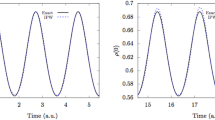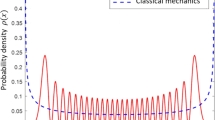Abstract
The representation of a quantum system as the spatial configuration of its constituents evolving in time as a trajectory under the action of the wave-function, is the main objective of the de Broglie–Bohm theory (or pilot wave theory). However, its standard formulation is referred to the statistical ensemble of its possible trajectories. The statistical ensemble is introduced in order to establish the exact correspondence (the Born’s rule) between the probability density on the spatial configurations and the quantum distribution, that is the squared modulus of the wave-function. In this work we explore the possibility of using the pilot wave theory at the level of a single Bohm’s trajectory, that is a single realization of the time dependent configuration which should be representative of a single realization of the quantum system. The pilot wave theory allows a formally self-consistent representation of quantum systems as a single Bohm’s trajectory, but in this case there is no room for the Born’s rule at least in its standard form. We will show that a correspondence exists between the statistical distribution of configurations along the single Bohm’s trajectory and the quantum distribution for a subsystem interacting with the environment in a multicomponent system. To this aim, we present the numerical results of the single Bohm’s trajectory description of the model system of six confined planar rotors with random interactions. We find a rather close correspondence between the coordinate distribution of one rotor, the others representing the environment, along its trajectory and the time averaged marginal quantum distribution for the same rotor. This might be considered as the counterpart of the standard Born’s rule when the pilot wave theory is applied at the level of single Bohm’s trajectory. Furthermore a strongly fluctuating behavior with a fast loss of correlation is found for the evolution of each rotor coordinate. This suggests that a Markov process might well approximate the evolution of the Bohm’s coordinate of a single rotor (the subsystem) and, under this condition, it is shown that the correspondence between coordinate distribution and quantum distribution of the rotor is exactly verified.








Similar content being viewed by others
References
Abramowitz, M., Stegun, I.A.: Handbook of Mathematical Functions. Dover Publications, New York (1972)
Bartsch, C., Gemmer, J.: Dynamical typicality of quantum expectation values. Phys. Rev. Lett. 102, 110403 (2009)
Berezovsky, J., Mikkelsen, M.H., Stoltz, N.G., Coldren, L.A., Awschalom, D.D.: Picosecond coherent optical manipulation of a single electron spin in a quantum dot. Science 320, 349 (2008)
Biercuk, M.J., Uys, H., VanDevender, A.P., Shiga, N., Itano, W.M., Bollinger, J.J.: Optimized dynamical decoupling in a model quantum memory. Nature 458, 07951 (2009)
Bohm, D.: A suggested interpretation of the quantum theory in terms of “hidden” variables. I. Phys. Rev. 85, 166 (1952)
Bohm, D.: A suggested interpretation of the quantum theory in terms of “hidden” variables. II. Phys. Rev. 85, 180 (1952)
Bohm, D.: Proof that probability density approaches \(|\psi |^2\) in causal interpretation of the quantum theory. Phys. Rev. 89(2), 15 (1953)
Braverman, B., Simon, C.: Proposal to observe the nonlocality of bohmian trajectories with entangled photons. Phys. Rev. Lett. 110, 060406 (2013)
Brody, T.A., Flores, J., French, J.B., Mello, P.A., Pandey, A., Wong, S.S.M.: Random-matrix physics: spectrum and strength fluctuation. Rev. Mod. Phys. 53, 385 (1981)
de Broglie, L.: Electrons et Photons, Rapport au Ve Conseil Physique Solvay. Gauhier-Villiars, Paris (1928)
de Broglie, L.: An Introduction to the Study of Wave Mechanics. E.P. Dutton and Company, New York (1930)
Christov, I.P.: Time-dependent quantum monte carlo: preparation of the ground state. N. J. Phys. 9, 70 (2007)
Cohen-Tannoudji, C., Diu, B., Laloë, F.: Quantum Mechanics. Wiley, New York (1977)
Colin, S., Struyve, W.: Quantum non-equilibrium and relaxation to equilibrium for a class of de broglie-bohm-type theories. N. J. Phys. 12, 043008 (2010)
Dürr, D., Goldstein, S., Zanghi, N.: Quantum equilibrium and the origin of absolute uncertainty. J. Stat. Phys. 67, 843 (1992)
Figalli, A., Klein, C., Markowich, P., Sparber, C.: Wkb analysis of bohmian dynamics. Commun. Pure Appl. Math. 67, 0581–0620 (2014)
Fresch, B., Moro, G.J.: Typicality in ensembles of quantum states: Monte carlo sampling versus analytical approximations. J. Phys. Chem. A 113, 14502 (2009)
Fresch, B., Moro, G.J.: Emergence of equilibrium thermodynamic properties in quantum pure states. I. Theory. J. Chem. Phys. 133, 034509 (2010)
Fresch, B., Moro, G.J.: Emergence of equilibrium thermodynamic properties in quantum pure states. II. Analysis of a spin model system. J. Chem. Phys. 133, 034510 (2010)
Fresch, B., Moro, G.J.: Beyond quantum micocanonical statistics. J. Chem. Phys. 134, 054510 (2011)
Fresch, B., Moro, G.J.: Typical response of quantum pure states. Eur. Phys. J. B 86, 233 (2013)
Garashchuk, S., Dell’Angelo, D., Rassolov, V.A.: Dynamics in the quantum/classical limit based on selective use of the quantum potential. J. Chem. Phys. 141, 234107 (2014)
Garashchuk, S., Rassolov, V.A.: Semiclassical dynamics based on quantum trajectories. Chem. Phys. Lett. 364, 562 (2002)
Garashchuk, S., Volkov, M.V.: Incorporation of quantum effects for selected degrees of freedom into the trajectory based dynamics using spatial domains. J. Chem. Phys. 137, 074115 (2012)
Gardiner, C.W.: Handbook of Stochastic Methods for Physics. Chemistry and the Natural Sciences. Springer, New York (1986)
Goldstein, S., Lebowitz, J.L., Mastrodonato, C., Tumulka, R., Zanghi, N.: Approach to thermal equilibrium of macroscopic quantum systems. Phys. Rev. E 81, 011109 (2010)
Goldstein, S., Lebowitz, J.L., Tumulka, R., Zanghi, N.: Canonical typicality. Phys. Rev. Lett. 96, 050403 (2006)
Herman, M., Perry, D.S.: Molecular spectroscopy and dynamics: a polyad-based perspective. Phys. Chem. Chem. Phys. 15, 9970 (2013)
Holland, P.R.: The Quantum Theory of Motion. Cambridge University Press, Cambridge (1995)
Huang, K.: Statistical Mechanics. Wiley, New York (1987)
Khinchin, A.Y.: Mathematical Foundation of Statistical Mechanics. Dover, New York (1949)
Krasnoshchekov, S.V., Stepanov, N.F.: Polyad quantum numbers and multiple resonances in anharmonic vibrational studies of polyatomic molecules. J. Chem. Phys. 139, 184101 (2013)
Linden, N., Popescu, S., Short, A.J., Winter, A.: Quantum mechanical evolution towards thermal equilibrium. Phys. Rev. E 79, 061103 (2009)
Lopreore, C.L., Wyatt, R.E.: Quantum wave packet dynamics with trajectories. Phys. Rev. Lett. 82(26), 5190 (1999)
Madelung, V.E.: Quantentheorie in hydrodynamischer form. Z. Phys. 40, 322 (1927)
Neumann, P., Mizuochi, N., Rempp, F., Hemmer, P., Watanabe, H., Yamasaki, S., Jacques, V., Gaebel, T., Jelezko, F., Wrachtrup, J.: Multipartite entanglement among single spins in diamond. Science 320, 1326 (2008)
von Neunmann, J.: Mathematical Foundations of Quantum Mechanics. Princeton University Press, Princeton (1955)
Nielsen, M.A., Chuang, I.L.: Quantum Computation and Quantum Information. Cambridge University Press, New York (2000)
Norsen, T.: The pilot-wave perspective on quantum scattering and tunneling. Am. J. Phys. 81, 258 (2013)
Norsen, T.: The pilot-wave perspective on spin. Am. J. Phys. 82, 337 (2014)
Philbin, T.G.: Derivation of quantum probabilities from deterministic evolution (2015)
Popescu, S., Short, A.J., Winter, A.: Entanglement and the foundations of statistical mechanics. Nat. Phys. 2, 754 (2006)
Press, W.H., Teukolsky, S.A., Vetterling, W.T., Flannery, B.P.: Numerical Recipes. Cambridge University Press, Cambridge (2007)
Reimann, P.: Foundation of statistical mechanics under experimentally realistic conditions. Phys. Rev. Lett. 101, 190403 (2008)
Sanderson, C.: Armadillo: an open source c\(++\) linear algebra library for fast prototyping and computationally intensive experiments. Technical Report, NICTA (2010)
Sawada, R., Sato, T., Ishikawa, K.L.: Analysis of strong-field enhanced ionization of molecules using bohmian trajectories. Phys. Rev. A 90, 023404 (2014)
Shannon, C., Weaver, W.: The Mathematical Theory of Communication. University of Illinois, Urbana (1949)
Shtanov, Y.V.: Origin of quantum randomness in the pilot wave quantum mechanics (1997)
Suter, D., Mahesh, T.S.: Spins as qubits: quantum information processing by nuclear magnetic resonance. J. Chem. Phys. 128, 052206 (2008)
Towler, M.D., Russell, N.J., Valentini, A.: Time scales for dynamical relaxation to the born rule. Proc. R. Soc. A 468, 990 (2012)
Valentini, A.: Signal-locality, uncertainty, and the subquantum H-theorem. I. Phys. Lett. A 156, 5 (1991)
Valentini, A.: Signal-locality, uncertainty, and the subquantum H-theorem. II. Phys. Lett. A 158, 1 (1991)
Wigner, E.P.: Random matrices in physics. SIAM Rev. 9(1), 1 (1967)
Wyatt, R.E.: Quantum wave packet dynamics with trajectoriers: application to reactive scattering. J. Chem. Phys. 111(10), 4406 (1999)
Wyatt, R.E.: Quantum wave packet dynamics with trajectoriers: wavefunction synthesis along quantum paths. Chem. Phys. Lett. 313, 189 (1999)
Zyczkowski, K.: Volume of the set of separable states. II. Phys. Rev. A 60, 3496 (1999)
Zyczkowski, K., Sommers, H.J.: Induced measures in the space of mixed quantum states. J. Phys. A 34, 7111 (2001)
Acknowledgments
The authors acknowledge the support by Univesità degli Studi di Padova through \(60\,\%\) grants. We thank the anonymous reviewers for critical comments and the suggestions.
Author information
Authors and Affiliations
Corresponding author
Rights and permissions
About this article
Cite this article
Avanzini, F., Fresch, B. & Moro, G.J. Pilot-Wave Quantum Theory with a Single Bohm’s Trajectory. Found Phys 46, 575–605 (2016). https://doi.org/10.1007/s10701-015-9979-1
Received:
Accepted:
Published:
Issue Date:
DOI: https://doi.org/10.1007/s10701-015-9979-1




